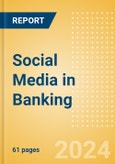Historically, the average return on equity for a social media giant is much higher than for a bank (maybe 5-10% for a bank versus 30% for social media firms), so there has been little incentive to apply for a banking license. However, the altered rate environment has changed the calculus on this, presenting a tantalising attack vector of lending with a lower cost of funding. Alongside that, social media companies are under pressure to diversify away from their ad-funded business model in the face of increased regulatory scrutiny. In 2023 alone, Alphabet, Amazon, ByteDance, and Meta were fined a combined $7.7 billion for breaching data privacy laws over their ad-targeting practices. Regulators have also accused them of monopolistic behavior around access to personal data. In 2023, Alphabet, ByteDance, Meta, and Microsoft were classified as “gatekeepers” under the EU’s latest antitrust legislation. All this points to a likely broadening and deepening of social media firms in consumer financial services.
Scope
- The single biggest demographic shift for incumbent banks will likely be the inversion in provider preferences. In the US, for example, customers aged 18-24 are nearly half as likely to prefer traditional providers (31%) versus the general population (56%) for their primary current account relationship.
- When looking at preferred research methods for financial products, 34% of respondents in the US aged 18-24 are likely to rely on family and friends versus 26% for the general population. This speaks to declining trust in traditional providers (and traditional sources of media) and a growing reliance on family and friends, both in person and via vast social networks and online communities.
- Across all regions, consumers value privacy and security over convenience and speed, which for social media giants like Meta (with well-documented privacy issues) suggests younger customers may not be the captive demographic.
Reasons to Buy
- Understand how social media giants’ traditional business models are evolving.
- Review which disruptive technologies (such as cloud, artificial intelligence, and the metaverse) confer the most advantages for social media giants, and where they represent compete or collaborate opportunities for incumbent banks.
- Interrogate how social and macroeconomic trends (such as ESG, BRIC economies, the gig economy, the subscription economy, diversity and inclusion, and gender empowerment) create new threats and opportunities for social media players and incumbent banks.
- Understand the latest regulatory trends impacting the social media business model, and where arbitrage opportunities exist for social media giants versus incumbent banks.
- Review the latest consumer survey data to understand the best attack vectors for social media giants (by channel, product, demographic, and technology), and how incumbent banks can drive retention among the most at-risk customer segments.
- View firm-level insight on the leading social media companies and how they have invested in new capabilities and features in anticipation of a deeper encroach into FS, as well as examples of how leading banks have responded.
Table of Contents
- Executive Summary
- Players
- Thematic Briefing
- Trends
- Technology trends
- Macroeconomic trends
- Regulatory trends
- Industry trends
- Timeline
- Industry Analysis
- Signals
- M&A trends
- Value Chain
- Direct entry
- Channel partner
- Technology partner
- UX paragon
- Companies
- Public companies
- Private companies
- Sector Scorecard
- Retail banking sector scorecard
- Glossary
- Further Reading
- Thematic Research Methodology
- About the Publisher
- Contact the Publisher
Companies Mentioned (Partial List)
A selection of companies mentioned in this report includes, but is not limited to:
- Amazon
- Apple
- Alphabet
- Tinkoff Bank
- AIB
- Capital One
- WE Bank
- MyBank
- Monzo
- Natwest/RBS
- Danske Bank
- DBS
- TSB
- BBVA
- Citibank
- mBank
- Revolut
- Credit Agricole
- Barclays
- CreditLadder
- NovaCredit
- Experian
- Equifax
- TransUnion
- Tink
- Bud
- Plaid
- TrueLayer
- Cornami
- Decentriq
- Immuta
- Inpher
- Statice








